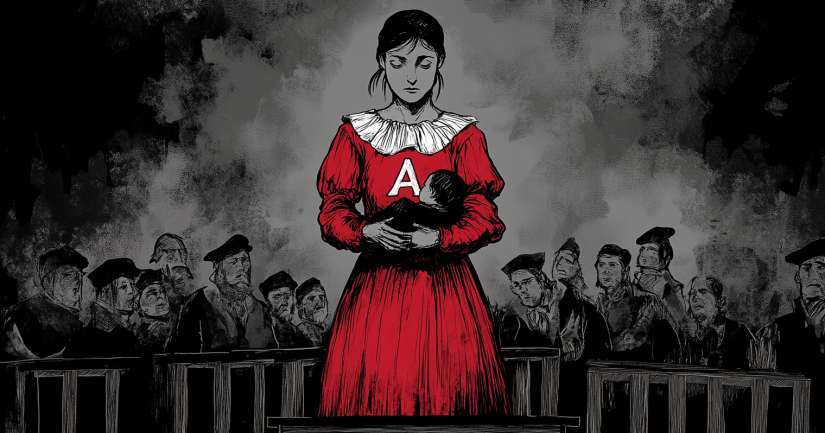
Delve into the unfolding drama in Scarlet Letter Chapter 2 Quiz, where Hawthorne’s vivid imagery sets the tone for the story. This quiz invites you to unravel the rich tapestry of themes and symbols that define this classic novel. As you embark on this journey, you will delve into the heart of Puritan society. You will explore the powerful imagery Hawthorne uses to depict sin, shame, and redemption. Each question will challenge your understanding of Hester Prynne’s public shaming and the complex characters around her.
In Chapter 2, the scaffold becomes a stage for moral scrutiny. You will examine the crowd’s reaction and the societal norms that bind them. This quiz will deepen your appreciation for Hawthorne’s intricate storytelling and his portrayal of human nature. You will connect with Hester’s resilience and explore the community’s harsh judgment.
Hester’s public humiliation sets the stage for a tale of secrecy and redemption. Continue unraveling the drama with the Scarlet Letter Chapter 3 and see how Dimmesdale reacts to this scandal. Or, if you’d like to start from the beginning, revisit the foundation of this classic with the Scarlet Letter Chapter 1. Want a bigger challenge? Put your full-book comprehension to the test in the Scarlet Letter Full Book Quiz.
Prepare to engage with the text on a new level. Test your knowledge and gain insights into the human condition as depicted in this timeless work. Let’s begin this literary adventure, where every answer brings you closer to the essence of The Scarlet Letter. Scarlet Letter Quizzes: From sin to redemption, explore every theme & chapter.
What Happened – Scarlet Letter Chapter 2
In Chapter 2 of The Scarlet Letter, a crowd gathers in front of the prison in a Puritan settlement. The people are waiting to witness a public punishment. A woman named Hester Prynne emerges from the prison. She is holding a baby in her arms. On her chest, she wears a large, embroidered letter A. This letter stands for adulteress, marking her crime.
Hester walks to the scaffold, a platform in the town square. The crowd watches her closely. They whisper and gossip about her sin. Some women in the crowd think her punishment is too light. They believe she should face a harsher penalty.
As Hester stands on the scaffold, she feels ashamed but remains calm. She looks at the faces in the crowd. Her past memories come to mind. She recalls her life before coming to this settlement. She thinks about her husband, who is not present. She also remembers a man she once loved.
Hester stands on the scaffold for several hours. During this time, people continue to stare and talk about her. Despite their judgment, she holds her head high. She clutches her baby tightly. The chapter ends with Hester still on the scaffold, facing the crowd’s judgment.
Scarlet Letter Chapter 2 – Quotes
- “The magistrates are God-fearing gentlemen, but merciful overmuch.” – Townsman, ‘Discussing the punishment of Hester Prynne, showing the community’s mixed feelings about leniency.’
“Thus she will be a living sermon against sin.” – Woman in the crowd, ‘Commenting on Hester’s public punishment and the purpose it serves for society.’
“Ah, but let her cover the mark as she will, the pang of it will be always in her heart.” – Elderly woman, ‘Speculating on Hester’s internal suffering despite any attempts to hide her shame.’
“It will not speak!” – Reverend Dimmesdale, ‘Expressing frustration over the baby’s inability to reveal its father’s identity, highlighting the theme of hidden sin.’
“She hath good skill at her needle.” – Townsman, ‘Noticing the quality of Hester’s handiwork on the scarlet letter, indicating her resilience and talent.’
Scarlet Letter Chapter 2 – FAQ
The scaffold in Chapter 2 serves as a symbol of public judgment and punishment. It is where Hester Prynne is displayed before the community as part of her sentence for adultery. This setting emphasizes the themes of shame, guilt, and societal scrutiny, central to the narrative.
Nathaniel Hawthorne portrays the crowd with a critical eye, highlighting its sternness and lack of compassion. The townspeople are depicted as harsh and judgmental, embodying the rigid Puritanical values of the time. Their presence underscores the oppressive social norms Hester faces.
Hester Prynne holds her infant daughter, Pearl, during the public shaming as a living symbol of her sin. The child is the result of her adulterous affair, and her presence intensifies Hester’s humiliation. Pearl’s innocence contrasts with the gravity of her mother’s punishment, adding complexity to the scene.
Hester Prynne exhibits a mix of defiance and vulnerability during her public humiliation. Despite the shame imposed upon her, she maintains her dignity, refusing to reveal the identity of Pearl’s father. Her poise and resilience suggest an inner strength that defies the community’s condemnation.
Chapter 2 establishes a tone of tension and moral complexity that permeates the novel. Through Hester’s punishment and the community’s response, Hawthorne introduces themes of sin, judgment, and redemption. This chapter sets the stage for the unfolding drama and the exploration of individual versus societal conflict.
